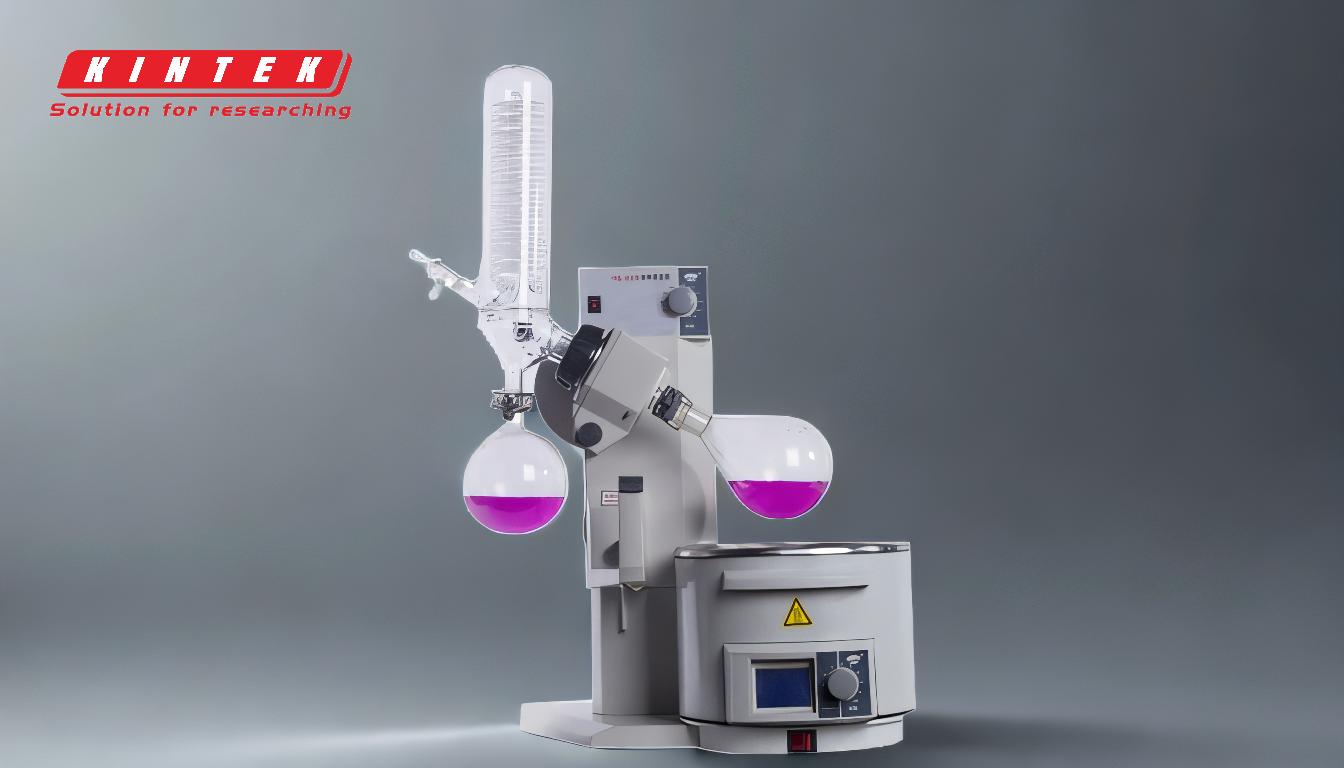Simple distillation and rotary evaporation are both separation techniques used in chemistry, but they differ significantly in their purpose, process, and outcomes. Simple distillation is a method used to separate components of a mixture based on differences in their boiling points, where the distillate (condensed vapor) is collected as the desired product. Rotary evaporation, on the other hand, is primarily used for solvent removal, where the residue (concentrated compound) is retained in the original flask after the solvent is evaporated under reduced pressure. Rotary evaporation is particularly effective for processing large quantities of low-boiling-point solvents, while simple distillation is more suited for purifying or separating compounds based on their volatilities. Below, the key differences and applications of these two techniques are explained in detail.
Key Points Explained:

-
Purpose and Application:
-
Simple Distillation:
- Used to separate components of a mixture based on differences in their boiling points.
- Ideal for purifying liquids or isolating volatile compounds from non-volatile impurities.
- Commonly used in laboratories for small-scale separations or when high purity is required.
-
Rotary Evaporation:
- Primarily used for solvent removal, especially for low-boiling-point solvents.
- Designed to concentrate compounds by evaporating the solvent under reduced pressure.
- Suitable for processing larger quantities of solvents and is widely used in chemical synthesis and sample preparation.
-
Simple Distillation:
-
Process and Mechanism:
-
Simple Distillation:
- Involves heating a mixture to its boiling point, allowing the more volatile component to vaporize.
- The vapor is then condensed back into a liquid (distillate) and collected separately.
- Operates at atmospheric pressure unless otherwise specified.
-
Rotary Evaporation:
- Uses a rotating flask to create a thin film of the sample, increasing the surface area for evaporation.
- Operates under reduced pressure (vacuum) and often with elevated temperatures to lower the boiling point of the solvent.
- The solvent is evaporated and condensed, while the concentrated residue remains in the original flask.
-
Simple Distillation:
-
Retained Product:
-
Simple Distillation:
- The distillate (condensed vapor) is typically the desired product and is collected for further use.
- The residue left in the distillation flask is often discarded or processed further.
-
Rotary Evaporation:
- The residue (concentrated compound) is the desired product and is retained in the original flask.
- The evaporated solvent is collected separately and is usually discarded or recycled.
-
Simple Distillation:
-
Pressure and Temperature Conditions:
-
Simple Distillation:
- Generally performed at atmospheric pressure unless a vacuum distillation setup is used.
- Requires heating to the boiling point of the most volatile component.
-
Rotary Evaporation:
- Operates under reduced pressure to lower the boiling point of the solvent, making it more efficient for solvent removal.
- Uses controlled heating to prevent degradation of temperature-sensitive compounds.
-
Simple Distillation:
-
Scale and Efficiency:
-
Simple Distillation:
- More suitable for small-scale separations or when high purity is required.
- Less efficient for removing large quantities of solvents or processing large volumes.
-
Rotary Evaporation:
- Highly efficient for removing large volumes of solvents, especially low-boiling-point solvents.
- Suitable for processing larger quantities and is often used in industrial or large-scale laboratory settings.
-
Simple Distillation:
-
Equipment and Setup:
-
Simple Distillation:
- Requires a distillation flask, condenser, and collection flask.
- Relatively simple setup but may require additional components for fractional or vacuum distillation.
-
Rotary Evaporation:
- Uses a rotary evaporator, which includes a rotating flask, vacuum pump, condenser, and collection flask.
- More complex setup but offers greater control over pressure and temperature.
-
Simple Distillation:
-
Applications in Chemistry:
-
Simple Distillation:
- Commonly used for purifying solvents, isolating essential oils, or separating liquid mixtures.
- Limited to compounds with significantly different boiling points.
-
Rotary Evaporation:
- Widely used in organic synthesis for concentrating reaction mixtures or isolating products.
- Ideal for processing temperature-sensitive compounds due to the reduced pressure and controlled heating.
-
Simple Distillation:
In summary, while both simple distillation and rotary evaporation are separation techniques, they serve different purposes and are used under different conditions. Simple distillation is ideal for purifying or separating compounds based on boiling points, while rotary evaporation excels at solvent removal and concentration under reduced pressure. Understanding these differences helps in selecting the appropriate technique for specific laboratory or industrial applications.
Summary Table:
| Aspect | Simple Distillation | Rotary Evaporation |
|---|---|---|
| Purpose | Separates components based on boiling points; collects distillate as the desired product. | Removes solvent under reduced pressure; retains concentrated residue as the product. |
| Process | Operates at atmospheric pressure; heats mixture to boiling point, condenses vapor. | Uses reduced pressure and rotation to evaporate solvent; condenses solvent separately. |
| Retained Product | Distillate (condensed vapor) is collected; residue is discarded. | Residue (concentrated compound) is retained; solvent is discarded or recycled. |
| Pressure & Temperature | Atmospheric pressure; requires heating to boiling point. | Reduced pressure; controlled heating to prevent compound degradation. |
| Scale & Efficiency | Suitable for small-scale separations; less efficient for large solvent volumes. | Highly efficient for large solvent volumes; ideal for industrial or large-scale labs. |
| Equipment | Requires distillation flask, condenser, and collection flask. | Uses rotary evaporator with rotating flask, vacuum pump, condenser, and collection flask. |
| Applications | Purifying solvents, isolating essential oils, separating liquid mixtures. | Concentrating reaction mixtures, isolating products, processing temperature-sensitive compounds. |
Need help choosing the right separation technique for your lab? Contact our experts today for personalized advice!










